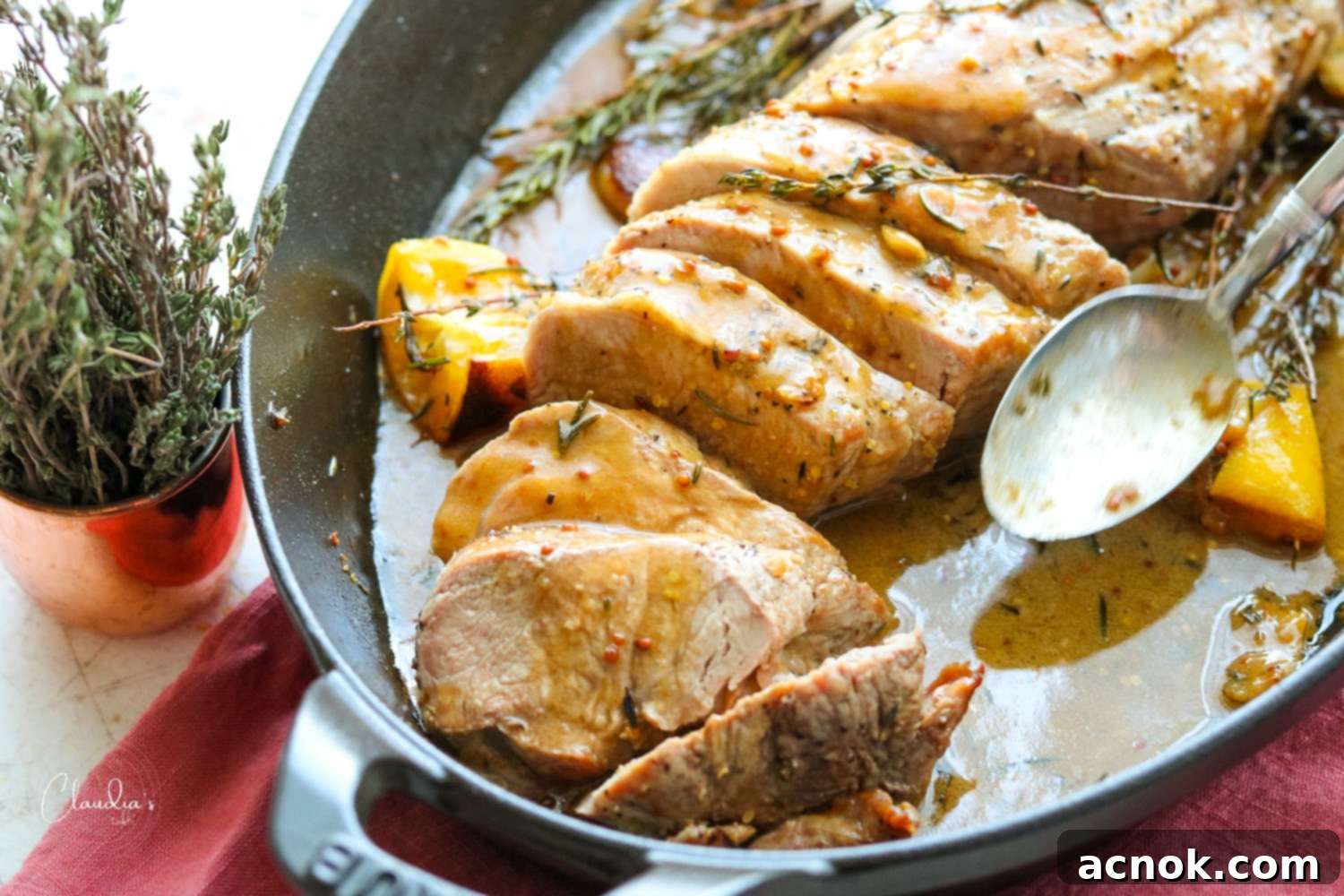Perfectly Seared Pork Tenderloin with Zesty Lemon Herb Pan Sauce: An Easy & Elegant Dinner
There’s nothing quite like a perfectly crafted pan sauce to elevate a meal, and this Pork Tenderloin with Lemon Herb Pan Sauce truly delivers. Imagine tender, succulent pork tenderloin, expertly seasoned and roasted to moist perfection, then generously drizzled with a vibrant, aromatic sauce. This isn’t just any sauce; it’s a harmonious blend of fresh herbs, pungent garlic, bright lemon, and a subtle hint of Dijon and grainy mustards that creates an irresistible flavor profile – truly “lick-the-plate” good. Paired with creamy mashed potatoes and crisp roasted asparagus, this dish transforms into an incredible, company-worthy dinner that’s surprisingly easy to prepare on any given weeknight.
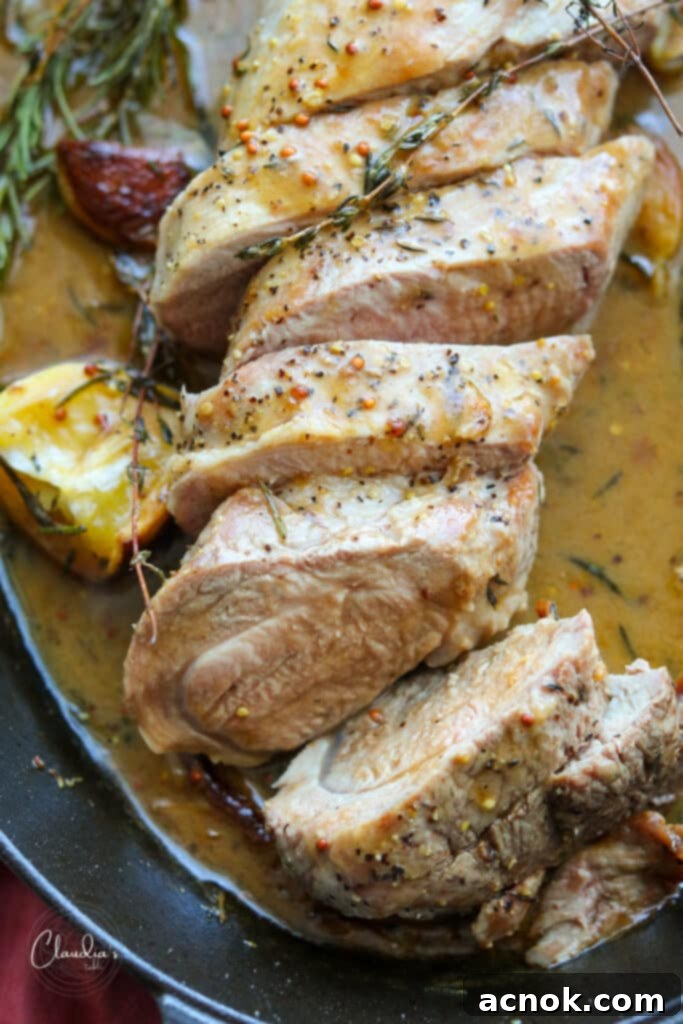
Table of contents
- About This Flavorful Pork Tenderloin Recipe
- Pork Tenderloin vs. Pork Roast: Understanding the Difference
- How to Buy the Best Pork Tenderloin
- How to Make Perfect Pork Tenderloin with Lemon Herb Pan Sauce
- Key Tips to Ensure Your Tenderloin Stays Moist
- Essential Ingredients for Success
- Step-by-Step Cooking Instructions
- Crafting the Delicious Pan Sauce
- What to Serve with Pork Tenderloin
- Frequently Asked Questions About Pork Tenderloin
- Explore More Delicious Recipes
About This Flavorful Pork Tenderloin Recipe
Lemons, fresh rosemary, and aromatic garlic are culinary powerhouses that form the foundation of many of my favorite dishes. They are true staples in my kitchen, versatile enough to complement nearly any ingredient. For this particular Pork Tenderloin with Lemon Herb Pan Sauce recipe, what started as a simple combination of lemon and herbs quickly evolved into a sophisticated, yet equally quick-to-prepare, meal that maximizes flavor. The result is a truly succulent pork tenderloin adorned with a vibrant, zesty lemon herb pan sauce. The addition of a hint of Dijon and grainy mustards introduces a depth and tanginess that perfectly balances the rich pork, creating an elegant finish. This recipe is robust enough for a special Sunday supper but also remarkably fast and fuss-free, making it an ideal candidate for your busy weeknight dinner rotation. There are no secret ingredients or complicated techniques here, just a thoughtfully selected combination of fresh, high-quality components that work together beautifully to create an unforgettable dish. I’m confident your family will adore this recipe, and it will quickly become a cherished favorite in your culinary repertoire.
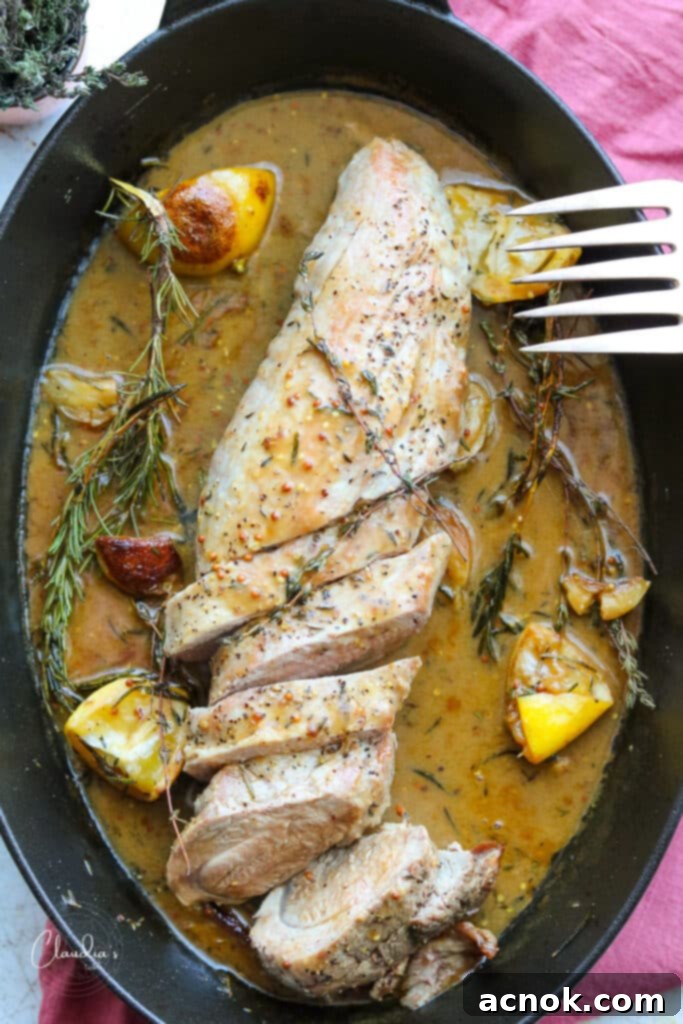
Pork Tenderloin vs. Pork Roast: Understanding the Difference
Many home cooks often wonder about the distinction between a Pork Tenderloin and a Pork Roast. While both are delicious cuts of pork, they differ significantly in size, fat content, and cooking time, making them suitable for different culinary applications.
A pork tenderloin is a long, slender, boneless cut of meat, renowned for its lean texture and inherent tenderness. Typically weighing between 1 to 1.5 pounds, these cuts cook remarkably fast, making them an excellent choice for quick weeknight dinners when time is of the essence. Another significant advantage of pork tenderloin is its affordability; you can frequently find them on sale at most major supermarkets, offering great value for a premium-feeling meal. Due to its low fat content, it’s crucial not to overcook it, as it can dry out quickly. However, with the right technique, it yields an incredibly moist and flavorful result.
In contrast, the term “pork roast” is a much broader, all-encompassing phrase that refers to several larger cuts of pork, such as pork butt, shoulder, or loin roasts. These cuts can be purchased with or without bones and contain significantly more fat and connective tissue. While they require longer cooking times, usually through slow-roasting, braising, or smoking, this higher fat content contributes to incredibly rich and succulent dishes like carnitas, pulled pork, or a hearty holiday roast. Their size and composition mean they are perfect for feeding a crowd or for dishes that benefit from hours of gentle cooking to break down those tougher fibers into melt-in-your-mouth tenderness.
For a quick, elegant, and straightforward meal like our Lemon Herb Pork Tenderloin, the tenderloin is undoubtedly the superior choice. Its delicate nature and rapid cooking time mean you can achieve a gourmet-quality dish without spending hours in the kitchen. Some people mistakenly believe that because tenderloins have less fat and no bones, they lack flavor. I strongly disagree! With proper searing, precise cooking temperatures, and the infusion of robust aromatics and a delectable pan sauce, a pork tenderloin can be incredibly tender, moist, and bursting with flavor.
How to Buy the Best Pork Tenderloin
When you’re at the grocery store, you’ll often find pork tenderloins packaged in pairs. This is a fantastic feature! I typically use one for my meal and freeze the other in a freezer-safe zip-top bag for a future dinner. The beauty of this cut’s compact size is that it defrosts quickly, allowing for spontaneous meal planning. Keep an eye out for sales, as tenderloins are frequently discounted, making this already economical cut even more budget-friendly.
You might also encounter pre-marinated pork tenderloins. While these can offer convenience, I personally prefer to buy un-marinated tenderloins. This allows me complete control over the flavor profile, ensuring I can infuse it with my preferred herbs, spices, and citrus, like the vibrant lemon and rosemary in this recipe. However, if you’re truly short on time, a quality pre-marinated option can certainly be an alternative, just be mindful of the ingredients and sodium content.
How to Make Perfect Pork Tenderloin with Lemon Herb Pan Sauce
Crafting a moist and flavorful pork tenderloin with lemon herb pan sauce involves a few key steps that guarantee success. The secret to achieving a juicy tenderloin lies in precise temperature control, ideally with the aid of an instant-read thermometer or a probe thermometer that can remain in the meat during cooking. The process typically begins with a crucial searing step, followed by finishing the roast in the oven. Searing creates a beautiful, caramelized crust on the exterior, locking in juices and significantly amplifying the overall flavors. For oven roasting, high heat is recommended to ensure a quick cook time without drying out the lean meat. I always suggest removing the tenderloin from the oven a few degrees *before* it reaches its ideal final doneness. This is because the meat will continue to cook as it rests (a phenomenon known as carry-over cooking), allowing its internal temperature to rise to the perfect point. During this essential resting period, you can swiftly whip up the exquisite pan sauce, ensuring a hot and perfectly coordinated dinner is served!
Key Tips to Ensure Your Tenderloin Stays Moist
The cardinal rule for a moist and tender pork tenderloin is simple: do not overcook it. Given that this is a relatively thin and lean cut of meat, it cooks much faster than you might anticipate. This is precisely why an accurate meat thermometer is your best friend – it makes the entire cooking process foolproof. While I will provide general time guidelines for those without a thermometer, I cannot stress enough the value of investing in one for any meat cookery. An instant-read thermometer is a true game-changer, eliminating all guesswork and ensuring consistent, perfectly cooked results every time. It’s the ultimate tool for confidence in the kitchen and guaranteeing your pork tenderloin remains incredibly juicy.
Another crucial step to maintaining moisture is allowing the pork to rest after cooking. Once removed from the oven, tenting the tenderloin loosely with aluminum foil allows the muscle fibers to relax and reabsorb the juices that have migrated to the center during cooking. This resting period not only ensures a juicier cut but also allows for carry-over cooking, gently bringing the meat to its final desired internal temperature without continued direct heat.
Essential Ingredients for Success
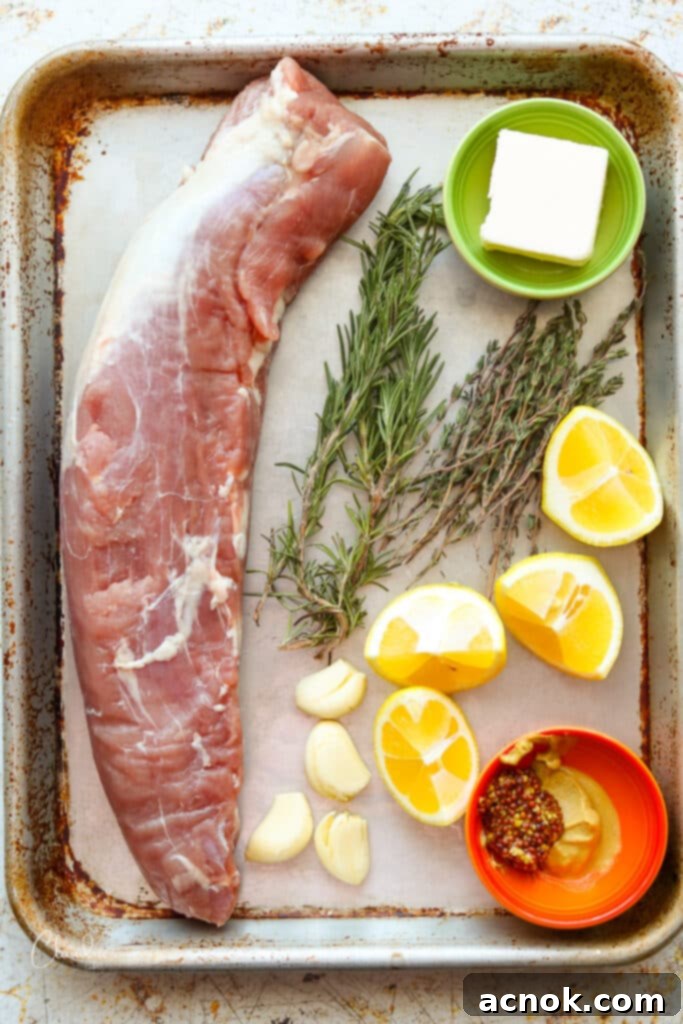
The beauty of this recipe lies in its simple yet powerful ingredients. Using fresh, high-quality components will truly make your Lemon Herb Pan Sauce shine. Opt for ripe, fragrant lemons and vibrant fresh herbs like rosemary and thyme for the best flavor. A good quality olive oil for searing and both Dijon and grainy mustards contribute significantly to the sauce’s depth and texture.
- 1 tbsp olive oil
- 1 1/2 lb pork tenderloin (average weight)
- 3 cloves garlic crushed
- 1 small lemon cut into quarters (use fresh, ripe lemons)
- 3 sprigs rosemary fresh
- 6-8 sprigs thyme, small
- 2 tbsp butter
- 1/2 cup chicken broth or vegetable, divided
- 1/3 cup white wine (a dry white wine like Sauvignon Blanc or Pinot Grigio works best)
- 1 tsp Dijon mustard
- 1 tsp Grainy mustard (if you can’t find, use an additional 1 tsp Dijon mustard)
- salt kosher (to taste)
- pepper, fresh ground (to taste)
- 1/2 tsp cornstarch optional (if needed to thicken sauce)
- 2 tbsp water optional (for cornstarch slurry)
Step-by-Step Cooking Instructions
Follow these detailed steps to achieve a perfectly cooked pork tenderloin with an exquisite lemon herb pan sauce.
- Preheat your oven to 400°F (200°C). This high heat helps achieve a good sear and quick roast.
- Prepare the pork tenderloin: Remove it from its packaging and thoroughly pat it dry with paper towels. A dry surface is crucial for a good sear. Sprinkle about 1/2 teaspoon of Kosher salt evenly over the tenderloin. If using regular table salt, use slightly less, as it’s saltier by volume. NOTE: Be careful not to over-salt at this stage, as you’ll be adding chicken broth and butter to the pan sauce, which also contain sodium. It’s always easier to adjust seasoning at the end than to try and fix an overly salty dish.
- Heat the skillet: In an oven-safe skillet (a cast iron skillet or stainless steel skillet works wonderfully for this), heat the olive oil over medium-high heat until it is shimmering but not smoking.
- Sear the tenderloin: Carefully add the pork tenderloin to the hot oil. Sear for 1 1/2 to 2 minutes on each side, ensuring each side develops a beautiful, golden-brown crust. This searing step is vital for building flavor and enhancing the texture of the pork. Once seared, turn off the stovetop heat.
- Add aromatics and roast: To the pan, add the lemon quarters, crushed garlic cloves, fresh rosemary, fresh thyme, and a generous crack of fresh ground pepper. Pour in about 1/4 cup of chicken broth.
- Transfer to oven: Place the skillet with the tenderloin and aromatics into the preheated oven. Roast for approximately 20-25 minutes, or until an instant-read thermometer inserted into the thickest part of the tenderloin reads 135°F (57°C).
- Rest the pork: Once the desired internal temperature is reached, carefully remove the skillet from the oven. Transfer the tenderloin from the pan to a clean plate. Loosely tent the pork with aluminum foil. NOTE: Tenting is key here! The tenderloin will continue to cook and its internal temperature will rise by a few degrees to reach the ideal final doneness of 145°F (63°C) while it rests. This resting period also allows the juices to redistribute throughout the meat, ensuring a more tender and moist result.
Crafting the Delicious Pan Sauce
While your pork tenderloin is resting, it’s the perfect time to prepare the incredible lemon herb pan sauce that will tie the entire dish together. This sauce is quick, easy, and bursting with flavor from the pan drippings.
- Deglaze the pan: Place the same skillet you used to roast the tenderloin back on the stovetop over medium-high heat. Add the 1/3 cup of white wine to the hot pan. Using a wooden spoon or spatula, scrape up all the flavorful crispy bits (fond) and any rendered fat from the bottom of the pan. This process, known as deglazing, incorporates all the rich, caramelized flavors left behind by the pork into your sauce. Allow the wine to simmer and reduce for about 1-2 minutes.
- Build the sauce: Once the wine has slightly reduced and the pan is deglazed, add the butter, the remaining 1/4 cup of chicken broth, 1 teaspoon of Dijon mustard, and 1 teaspoon of grainy mustard. Whisk continuously until all ingredients are fully combined and the butter has melted, creating a smooth, emulsified sauce.
- Thicken the sauce: Allow the sauce to gently simmer for about 3-5 minutes, whisking occasionally, until it naturally thickens to your desired consistency. If the sauce isn’t thickening enough, you can create a quick cornstarch slurry: In a small bowl, whisk together 1/2 teaspoon of cornstarch with 1-2 tablespoons of cool water until smooth. Gradually whisk this mixture into the simmering pan sauce and continue to stir until it thickens.
- Final adjustments: Taste the sauce and adjust for salt and pepper as needed. Remove and discard the spent lemon wedges, garlic cloves, and herb stems from the pan. Turn off the burner. Your exquisite pan sauce is now ready to serve!
- Serve: By now, your tenderloin should have rested sufficiently and reached an internal temperature of about 145ºF (63°C). Slice the pork crosswise against the grain into medallions. Arrange the slices on plates and generously spoon the warm lemon herb pan sauce over the pork. If, for any reason, the tenderloin did not reach 145ºF internal temperature during resting, you can simply place the sliced pork medallions directly into the simmering pan sauce for a minute or two over medium heat; they will finish cooking quickly.
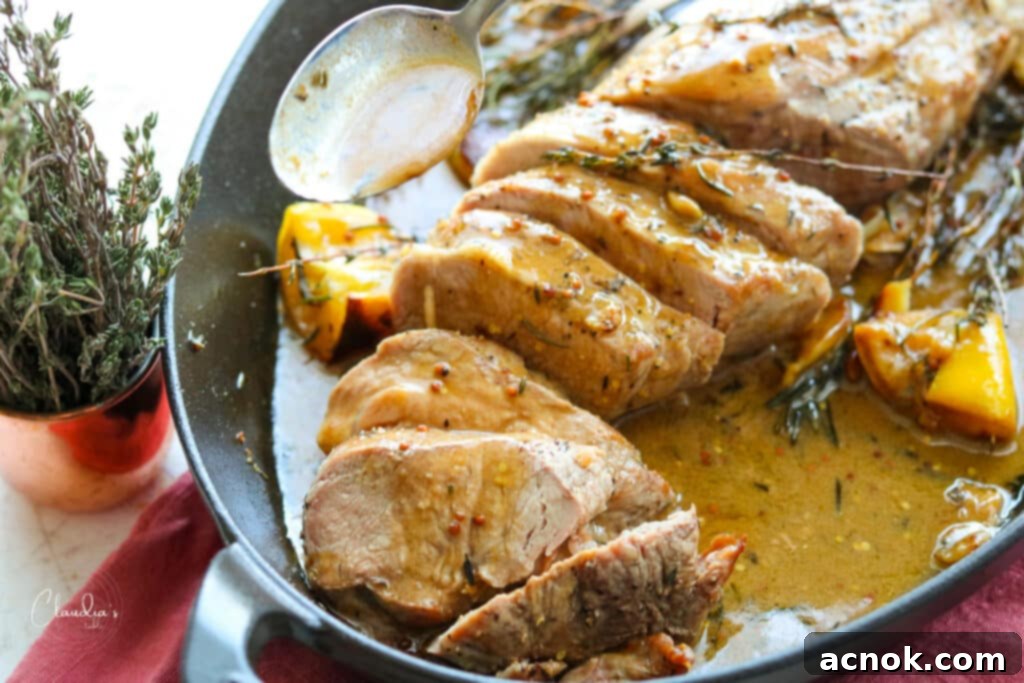
What to Serve with Pork Tenderloin
This versatile Pork Tenderloin with Lemon Herb Pan Sauce pairs beautifully with a variety of side dishes, making it easy to create a complete and satisfying meal. Here are some of my favorite accompaniments that perfectly complement the rich flavors of the pork and the zesty sauce:
- Creamy Mashed Potatoes: The ultimate classic pairing. Their smooth texture and buttery flavor provide a comforting contrast and absorb every last drop of the delicious pan sauce.
- Roasted Asparagus or Green Beans: Simple roasted green vegetables add a fresh, vibrant crunch and a hint of earthy sweetness. A squeeze of lemon on top enhances the meal’s bright flavors.
- Lemon Thyme Couscous with Olives: For a more Mediterranean flair, this light and fluffy couscous dish, infused with complementary lemon and thyme, offers a delightful texture and briny notes from the olives.
- Hearty Radicchio Pear Salad with Maple Vinaigrette: The slight bitterness of radicchio, sweetness of pear, and bright maple vinaigrette provide a refreshing counterpoint to the richness of the pork.
- Wild Rice Pilaf: A more substantial grain option, wild rice offers a chewy texture and nutty flavor that stands up well to the robust sauce.
DINNER TONIGHT: Are you making this tonight? And need it on the table fast? Try frozen, steamed veggies and a quick, microwaveable wild rice mix packet. This dish is designed for speed and flavor!
Frequently Asked Questions About Pork Tenderloin
Absolutely! Searing is a critical step for enhancing both the flavor and appearance of your pork tenderloin. The high heat of the skillet creates a beautiful, caramelized crust through the Maillard reaction, which develops complex, savory flavors that you simply can’t achieve by roasting alone. Furthermore, these delicious browned bits left in the pan after searing are essential for building the rich, deep flavor profile of our lemon herb pan sauce. While searing doesn’t necessarily “seal in the juices” (a highly debated topic in culinary science), it undeniably contributes to a superior taste and texture for the finished protein.
The key to preventing your pork tenderloin from drying out is precise temperature control and avoiding overcooking. Since it’s a lean cut, it’s very susceptible to becoming tough and dry if cooked too long. Ideally, a 1.5 lb tenderloin will cook to perfection in about 20-25 minutes in a 400°F (200°C) oven, as demonstrated in this recipe. However, I cannot emphasize enough the importance of an instant-read thermometer or an oven-safe probe thermometer. Insert it into the thickest part of the meat and remove the tenderloin when it reaches 135-140°F (57-60°C). The internal temperature will continue to rise to the safe and juicy 145°F (63°C) during its resting period, ensuring maximum moisture.
For a 1 to 1.5 lb pork tenderloin, approximately 20-25 minutes at 400°F (200°C) is a good guideline after searing. However, cooking time can vary based on oven calibration, the exact thickness of your tenderloin, and whether it’s coming straight from the fridge or has rested at room temperature. Always rely on an internal temperature of 135-140°F (57-60°C) when removed from the oven, allowing it to reach 145°F (63°C) after resting, rather than strictly on time to ensure perfect doneness.
Yes, absolutely! While the combination of both Dijon mustard and grainy mustard adds a wonderful complexity and texture to the pan sauce, you can certainly use all Dijon mustard if grainy is unavailable. Dijon will still provide that essential tangy, slightly spicy kick and help to emulsify the sauce beautifully. If you prefer a smoother sauce, using only Dijon would be ideal. If you have grainy mustard, it adds a lovely textural element and a slightly milder, earthier mustard flavor.
Yes, this recipe and its delicious lemon herb pan sauce can definitely be adapted for pork chops! You can follow the same basic searing and roasting instructions. However, it’s important to note that the cooking time will depend heavily on the thickness of your pork chops. Thicker, bone-in chops will take longer, while thinner, boneless chops will cook very quickly. Always use a meat thermometer; pork chops should reach an internal temperature of 145°F (63°C) and be allowed to rest. Keep a close eye on them to prevent overcooking and ensure they remain juicy.
The pan showcased in the photos is a versatile stove-to-oven Staub oval cast iron pan. Its excellent heat retention and oven-safe properties make it perfect for searing on the stovetop and then seamlessly transferring to the oven for roasting, before bringing it back to create the pan sauce. It’s a fantastic piece of kitchen equipment for efficiency and even cooking. (This is not an ad, just a helpful product identification!)
PRO TIP: This incredible lemon herb pan sauce recipe isn’t just for pork! It works wonderfully for chicken as well. Simply substitute the pork tenderloin for boneless, skinless chicken thighs or breasts. Follow the recipe instructions exactly, but ensure the chicken is fully cooked through, reaching an internal temperature of 165°F (74°C) before removing it from the oven. Tenting is not strictly necessary for chicken in the same way it is for lean pork, but a short rest is always beneficial. If you adore the classic lemon and rosemary combination, you’ll also love my One Pan Lemon Rosemary Chicken and Rice recipe!
If you tried this recipe, please help other readers by commenting below and sharing some stars! We 🫶🏼 appreciate you!
All content and photographs ©Claudia’s Table and claudiastable.com
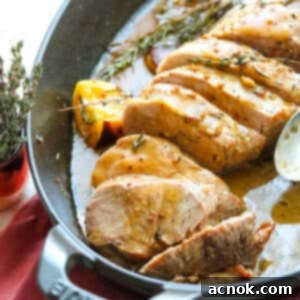
Pork Tenderloin with Lemon Herb Pan Sauce
Ana | Claudia’s Table
March 18, 2023
Pin Recipe
Equipment
-
1 oven safe skillet 12 inch
Ingredients
- 1 tbsp olive oil
- 1 1/2 lb pork tenderloin
- 3 cloves garlic crushed
- 1 small lemon cut into quarters
- 3 sprigs rosemary fresh
- 6-8 sprigs thyme small
- 2 tbsp butter
- 1/2 cup chicken broth or vegetable, divided
- 1/3 cup white wine
- 1 tsp Dijon mustard
- 1 tsp Grainy mustard if you can’t find use Dijon mustard
- salt kosher
- pepper ground
- 1/2 tsp cornstarch optional if needed to thicken sauce
- 2 tbsp water optional for cornstarch
Serving suggestions
- mashed potatoes
- cooked green beans
Instructions
-
Preheat oven 400F
-
Remove the tenderloin from its packaging and pat dry. Add a pinch of kosher salt to each side of the tenderloin.
-
NOTE: Make sure not to over season, as the drippings will be used for the pan sauce. You can adjust salt while you are making the pan sauce.
-
In a cast iron or oven safe skillet, add olive oil and heat until shimmering.
-
Carefully add the tenderloin to the hot pan and sear each side for 1 1/2-2 minutes.
-
Remove the pan from the heat on the stovetop.
-
Add lemon wedges, garlic cloves herbs and 2 tbsp of chicken broth.
-
Place the pork loin in the oven and roast for 25 minutes or until the internal temperature is 140F (the ideal internal temperature is 145F, but the tenderloin will continue to cook once removed from the oven and allowed to rest).
-
Remove from oven and place on stovetop.
-
Remove tenderloin and place on a plate. Place a piece of foil over the tenderloin loosely.
-
Turn the burner on to medium-high heat, and deglaze the pan with about 1/3 cup of white wine. Scrape the pan and allow the sauce to reduce. Add the remaining chicken broth, butter, and mustard. Whisk until thoroughly combined, and allow it to reduce and thicken. About 2-3 minutes.
-
If the sauce doesn’t thicken, add a cornstarch mixture of 1/2 tsp of cornstarch mixed with 2 tbsp of water.
-
Once thickened, taste for salt and add pepper and adjust as needed. Remove lemon, garlic, herb stems and discard. Turn burner off and it’s ready to serve.
-
Check tenderloin internal temp to ensure it’s reached 145F. Slice against the grain of the meat.
-
Serve with pan sauce on top with your favorite potato dish and veggies.
Notes
Nutrition
Nutritional information is calculated online and should be used as a guide.
All content and photographs ©Claudia’s Table and claudiastable.com
Explore More Delicious Recipes
- Pasta with Grilled Vegetables, Feta, and Lemon
- Grilled Asian Marinated Flank Steak
- Classic Homemade Chunky Blue Cheese Dressing
- 3-Ingredient Crispy Oven-Roasted Potatoes
- Grilled Peach Avocado Chicken Salad
